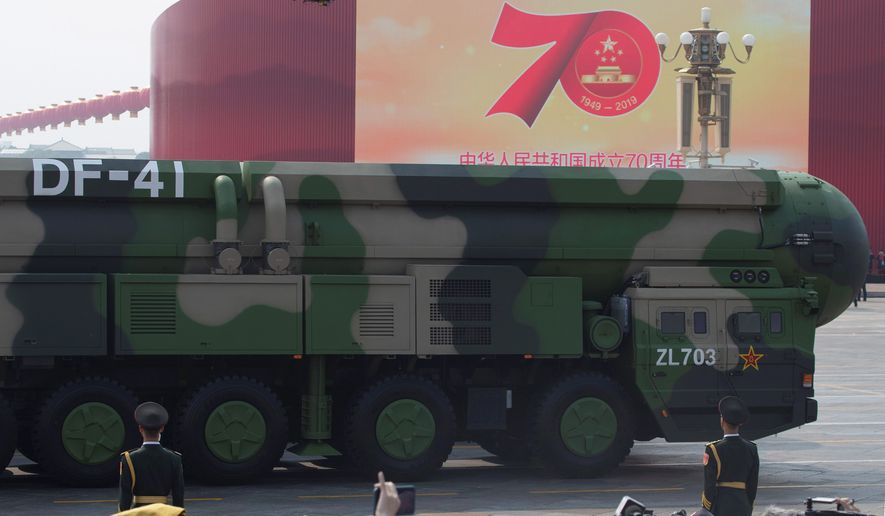China has conducted a flight test of its newest long-range missile, the Dong Feng 41, multi-warhead nuclear strike weapon, the Pentagon confirmed Monday.
The Nov. 22 flight was the first reported test of the DF-41 since May 2018, said a Pentagon official who spoke on condition of anonymity.
U.S. intelligence agencies believe the missile has already been deployed, based on its appearance during the Oct. 1 military parade in Beijing, where it was the centerpiece. A total of 16 DF-41s were showcased and Beijing officials at the time boasted that the new missile will be a key element of China’s efforts to confront the U.S.
A Pentagon spokesman declined to comment on the Chinese missile test. A Chinese Embassy spokesman did not return an email seeking comment on the missile test.
Separately, China watcher Henri Kenhmann, who operates the blog East Pendulum, reported a possible missile test was carried out around 6:30 p.m. in China on Friday, based on announced air closure zones. The missile was likely fired from a launch center in northwestern China and landed in a remote region of the Gobi Desert.
“The impact zone is similar to those of previous DF-41 trials in December 2016 and November 2017 and January and May of 2018,” he tweeted.
Additionally, China also conducted a flight test a week before the DF-41 test of the DF-31 ICBM, an older and shorter range missile that is part of China’s rapidly expanding nuclear arsenal.
Adm. Philip Davidson, commander of the Indo-Pacific Command, told Congress in March that China has been testing nuclear missiles, including the DF-41.
“Beijing continues testing its DF-41 road-mobile intercontinental ballistic missile (ICBM), which carries multiple, independently targetable re-entry vehicles and has a range of up to 9,300 miles,” Adm. Davidson said at the time.
The DF-41 will carry between six and 10 warheads, according to military analysts. In the past, Chinese nuclear missiles were outfitted with a single large warhead. Until this month, China’s most recent long-range missile test known publicly was the test-firing of a JL-3 submarine-launched ballistic missile in June.
China has used high-profile missile tests in the past to send messages to the U.S. For example, the 2017 DF-41 flight test took place two days before President Trump visited China. Similarly, the JL-3 missile test coincided with the visit by then-Acting Defense Secretary Patrick M. Shanahan, who was in the region to give a speech highlighting the threat posed by China.
Major China buildup
The road-mobile DF-41 intercontinental ballistic missile is part of a major buildup of Chinese nuclear forces that includes a variety of intercontinental and intermediate-range missiles, hypersonic glide vehicles, new ballistic missile submarines and a new strategic bomber.
Lt. Gen. Robert Ashley Jr., director of the Defense Intelligence Agency, said in a speech earlier this year that China is on pace to double the size of its nuclear arsenal in what he described as “the most rapid expansion and diversification of its nuclear arsenal in China’s history.”
One indicator of the scale of the buildup has been China’s large number of missile tests.
“Last year, China launched more ballistic missiles for testing and training than the rest of the world combined,” Gen. Ashley said in a speech to the Hudson Institute.
The congressional U.S.-China Economic and Security Review Commission’s latest annual report, made public two weeks ago, said the China is pushing the bounds of Beijing’s announced policy of maintaining a “minimal” nuclear deterrent.,
David Santoro, director and senior fellow for nuclear policy at the Pacific Forum, told the commission that with the addition of the DF-41, China “now possesses an arsenal more capable of striking the U.S. homeland than ever before,” adding that China is making “significant enhancements in its capabilities.”
Rick Fisher, a military affairs expert with the International Assessment and Strategy Center, said the DF-41 test was the 11th test since 2012 of the new missile.
The latest test “should settle beyond any doubt that this 10-warhead, multiple, independently targetable reentry vehicle (MIRV) capable ICBM is now targeting the United States,” he said.
Mr. Fisher warned that the DF-31 test highlights Beijing’s drive to develop a new variant, the DF-31AG, also viewed during the recent military parade. The new DF-31 is said to be deployed on a new road-mobile launcher that can be fired from a greater number of launch sites, increasing its survivability in a conflict.
“When you consider that China may be deploying three or four new MIRV-capable ICBMs, the DF-41 road-mobile, DF-41 rail-mobile, plus silo-based DF-5B and DF-5C, we may now be seeing a period of rapid growth in PLA nuclear warheads capable of attacking Americans,” Mr. Fisher said.
“This does not yet count the potentially MIRV-capable JL-3 submarine launched ballistic missile now in its early testing phase.”
• Bill Gertz can be reached at bgertz@washingtontimes.com.




Please read our comment policy before commenting.